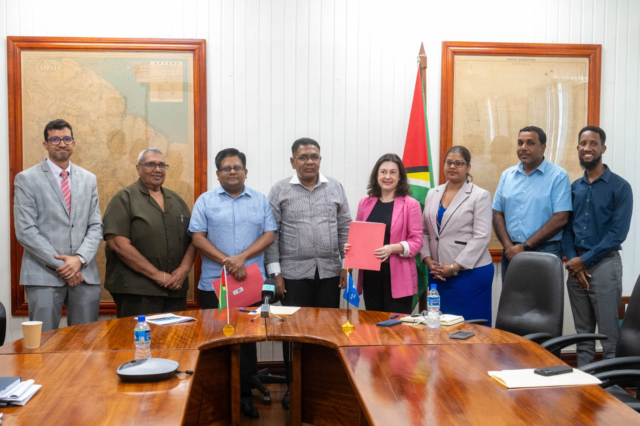Senior Minister with responsibility for Finance and the Public Service, Dr Ashni Singh, signed a US$45 million agreement with the World Bank on Monday for the Coastal Adaptation and Resilience (CARes) project.
Signing on behalf of the World Bank was its Resident Representative, Diletta Doretti. The CARes project marks the second largest investment to date being financed through the Guyana REDD+ Investment Fund (GRIF), established by the government pursuant to the Guyana-Norway partnership under the original Low Carbon Development Strategy (LCDS). It allows for the utilization of the remaining portion of the over US$220 million earned by Guyana for its forest climate services.
This US$45 million CARes project will see the rehabilitation or complete replacement of more than 45 kokers/sluices across Guyana and builds on government’s efforts to enhance flood risk management. This intervention will increase Guyana’s resilience and adaptive capacity to prevent, manage and mitigate flooding across its coastal regions, safeguarding lives and livelihoods and building on the extensive investment that the Government has made in strengthening its coastal resilience.
The Ministry of Agriculture will be the project’s executing agency while the World Bank will act as a partner entity, bringing its technical expertise on flood risk resilience and its fiduciary, social and environmental safeguards.
Minister Singh, while delivering remarks, highlighted that under the leadership of President Irfaan Ali, the government has significantly ramped up investments to address the strengthening, expansion and rehabilitation of the country’s Drainage and Irrigation (D&I) infrastructure, which lays the foundation for rapid growth in agriculture, and improvement in quality of life being enjoyed by the citizens who live in all of the areas that will now be better protected from the risk of flooding.
Dr. Singh further detailed that the CARes project is financed under GRIF, which has its origins in the original LCDS 2009, when the then-President, Dr Bharrat Jagdeo, called for new global models for low-deforestation development pathways.
This culminated in the 2009 Guyana-Norway Agreement, under which Norway paid Guyana over US$220 million for its forest climate services for the period 2009 to 2015. The new and expanded LCDS 2030 builds from an original vision set out in 2009, and now provides for Guyana to receive revenues for forest climate services from global voluntary carbon markets.
On December 1, 2022, the Architecture for REDD+ Transactions announced the issuance of 33.47 million TREES credit to Guyana for the five-year period from 2016 to 2020. On December 2, 2022, the Government of Guyana entered into an agreement with the Hess Corporation for the sale of carbon credits for a minimum of US$750 million between 2022 and 2032.
During brief remarks, Minister of Agriculture, Zulfikar Mustapha, said that the project is in keeping with the government’s continuous vision in enhancing the country’s D&I infrastructure. This will contribute significantly to the country’s goal of becoming a lead food production hub and exporter of agricultural produce to the Caribbean Region. He further noted that with the utilization of the oil and gas revenue, all sectors are being developed and modernized to be made more resilient and competitive.
Diletta Doretti, World Bank Group Resident Representative for Guyana and Suriname, during her remarks said that the project is also a critical component of Guyana’s LCDS aligning with the country’s broader vision for climate resilient growth.
Under Component 1 of the CARes project, the rehabilitation and replacement of kokers will benefit an estimated population of 320,000 people and assist in protecting approximately 130 sq. km of urbanised area and 1,270 sq. km. of agricultural land in the connected catchments.
Under Component 2, the investments will continue to enhance the National Drainage and Irrigation Authority’s (NDIA) capacity and capability to manage and operate drainage infrastructure assets and apply flood risk management principles in spatial planning of new developments.
So far, funds earned through the Guyana-Norway partnership under the original LCDS have been invested in 18 projects, and are being implemented under different thematic areas including socio-economic development, climate resilience and adaptation, hinterland development, digital infrastructure, and renewable energy.
Of the 18 projects, six are still under implementation: the Amerindian Land Titling Project; the Sustainable Land Development and Management Project; the ICT Access and e-Services for Hinterland Poor and Remote Communities Project; Support to the National Toshaos’ Council; the recently launched Guyana Solar Energy Project for 33 MW of renewable energy across Berbice, Essequibo and Linden; and now the Coastal Adaptation and Resilience (CARes) Project.













